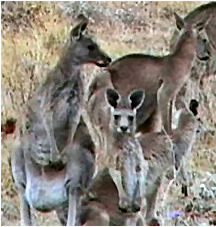The Weekly Times promoted the so-called ‘commercial culling’ of kangaroos in Victoria, where it is currently banned, in an opinion piece by John Kelly, Executive Officer of the Kangaroo Industries Association of Australia. (“It’s time to say hoor-roo,” May 14, 2008, p.17.)

John Kelly correctly writes that in Victoria there are no reliable estimates of the size of the kangaroo population.
“Virtually nothing goes into ensuring the animal is protected or managed in any way. The state has no clear idea how many kangaroos it supports, where they live, what’s happening to their populations in response to seasonal conditions or, most disturbingly, how healthy they are."
He is right. Unfortunately the Victorian Government either doesn’t care, or it may actually want to get rid of wildlife because preserving it means restraints on development and human population growth.
But, with a kind of shoot first and ask questions later logic, Kelly argues that, “Establishing a commercial harvest and the data collection mechanisms required to implement it instantly changes all this.” He means that the Kangaroo industry should be given a license to kill kangaroos in exchange for doing the government’s job of collecting statistics.
We do need good data collection mechanisms because the data available on the structure of kangaroo populations and the size and health of individuals gives reason for anxiety. To authorize commercial kills in return for data, however, is to put the cart before the horse and then shoot the horse as a good business deal and good for horses.
Kelly cites the RACV as having recently reported an increase in animal collisions in 2005 of 43 per cent over the previous two years.
Kelly then proceeds to create an impression that
(a) kangaroos are the cause of increasing road collisions; and that
(b) they therefore must be more numerous.
Shamelessly he concludes that “It is also reasonable to expect a well managed kangaroo harvest to reduce this [imagined kangaroo proliferation].”
Let us look at the first claim, that animal collisions are increasing. Kelly implies that collisions (with all kinds of animals) are increasing because the number of animals is increasing. According to the AWPC, however, this does not make sense:
“Likely reasons for more animal collisions are more toll-ways, roads and suburban expansion. More cars and human activities are coming into conflict with animals who were previously in safe habitats in Victoria."
“Humans are the only species in Australia that is rapidly increasing and our numbers and expansion coincide with a decrease in other species.”
Indeed, uprooted dying trees and devastated grasslands are a familiar sight in Australia, a country where extinctions are proceeding at a greater pace than almost any other country on earth (refs: 1301.0 - Year Book Australia, 1990 and 1301.0 - Year Book Australia, 2008
The overall trend is a decrease in other species and a higher death rate. Commercial kangaroo killing will only accelerate the death rate.
If a farmer built a housing estate in his front paddock and chased all his stock out onto the road, would he count the pile of corpses and conclude that there were more cows in his front paddock as a result? This is what the Kangaroo Industries Association of Victoria seems to be doing.
Maryland Wilson, President of the Australian Wildlife Protection Council (AWPC) agrees that more accurate counting, assessment, protection and better treatment is necessary, but cannot agree that there is any evidence that the numbers could warrant kangaroo killing commercialisation. The AWPC came to the opposite conclusion through scientifically based and accurate counting of kangaroos and other wildlife in local areas, starting with the Mornington Peninsula. The AWPC warns that the population structures and the trends in numbers long-term point to high extinction risks unless we protect the animals from road and suburb encroachment by providing connecting corridors and protecting and extending habitats.
But Kelly writes, “Put it altogether and a commercial kangaroo harvest would be worth well over $15 million a year to Victoria. It turns a shameful waste into a valuable resource and delivers better kangaroo damage mitigation to embattled farmers and better animal welfare outcomes than current practices.” In a final flourish, he adds, “It is [also] likely to improve public safety on roads, helps to protect plant bio-diversity from overgrazing, and creates jobs in the bush. Why not do it?"
But Maryland Wilson of the AWPC, said that Mr Kelly’s conclusions are simply astounding.
“Mr Kelly is completely out of date, even citing the industry’s own authorities. Gordon Grigg, the author of the industry ‘bible’, 'Commercial Harvesting of Kangaroos in Australia', upon whose research the industry developed, recently repudiated his original conclusions. He stated that, 'The damage done on grazing lands by kangaroos has been overestimated by up to 500%.' His conclusion was that, 'This would mean that kangaroos are a much smaller component of the total grazing pressure than is generally accepted'. And he concluded that, 'The hope of getting a significant improvement in wool production by pest-control of kangaroos is probably doomed to failure'".
(Grigg citation by Juliet Gellatley, UK zoologist, in, "Slaughter of the innocents", Viva Life, UK, Spring, 2002.)

Add comment